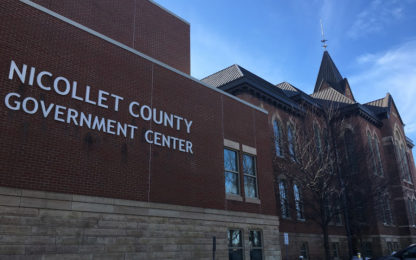AP FACT CHECK: False claims flood Trump-Biden debate

By CALVIN WOODWARD and HOPE YEN Associated Press
WASHINGTON (AP) — President Donald Trump unleashed a torrent of fabrications and fear-mongering in a belligerent debate with Joe Biden, at one point claiming that the U.S. death toll would have been 10 times higher under the Democrat because he wanted open borders in the pandemic.
Biden preached no such thing.
Trump barreled into the debate Tuesday night as unconstrained by the facts as at his rallies, but this time having his campaign opponent and frequently the Fox News moderator, Chris Wallace, calling him out in real time, or trying.
Biden stumbled on the record at times as the angry words flew from both men on the Cleveland stage.
A look at how some of their statements from Cleveland stack up with the facts in the first of three scheduled presidential debates for the Nov. 3 election:
VIRUS DEATH TOLL
TRUMP, addressing Biden on U.S. deaths from COVID-19: “If you were here, it wouldn’t be 200,000 people, it would be 2 million people. You didn’t want me to ban China, which was heavily infected…. If we would have listened to you, the country would have been left wide open.”
THE FACTS: The audacious claim that Biden as president would have seen 2 million deaths rests on a false accusation. Biden never came out against Trump’s decision to restrict travel from China. Biden was slow in staking a position on the matter but when he did, he supported the restrictions. Biden never counseled leaving the country “wide open” in the face of the pandemic.
Trump repeatedly, and falsely, claims to have banned travel from China. He restricted it.
The U.S. restrictions that took effect Feb. 2 continued to allow travel to the U.S. from the Chinese territories of Hong Kong and Macao. The Associated Press reported that more than 8,000 Chinese and foreign nationals based in the two locales entered the U.S. in the first three months after the travel restrictions were imposed.
Additionally, more than 27,000 Americans returned from mainland China in the first month after the restrictions took effect. U.S. officials lost track of more than 1,600 of them who were supposed to be monitored for virus exposure.
Dozens of countries took similar steps to control travel from hot spots before or around the same time the U.S. did.
___
PROTESTS
TRUMP: “The (Portland, Oregon) sheriff just came out today and he said I support President Trump.”
THE FACTS: That is false. The sheriff of Multnomah County, Oregon — where Portland is located — said he does not support Trump.
The sheriff, Mike Resse, tweeted: “As the Multnomah County Sheriff I have never supported Donald Trump and will never support him.”
Portland has been a flashpoint in the debate over racial injustice protests in the U.S. Police and federal agents have repeatedly clashed with demonstrators gathered outside the downtown federal courthouse and police buildings. Some protesters have thrown bricks, rocks and other projectiles at officers. Police and federal agents responded by firing tear gas, rubber bullets and other non-lethal ammunition to disperse the crowds.
___
BIDEN: “There was a peaceful protest in front of the White House. What did he do? He came out of his bunker, had the military do tear gas.”
THE FACTS: It was law enforcement, not the military, that used chemical irritants to forcefully remove peaceful protesters from Lafayette Square outside the White House on June 1.
And there is no evidence President Trump was inside a bunker in the White House as that happened. Secret Service agents had rushed Trump to a White House bunker days earlier as hundreds of protesters gathered outside the executive mansion, some of them throwing rocks and tugging at police barricades.
___
HEALTH CARE
TRUMP: “Drug prices will be coming down 80 or 90%.”
THE FACTS: That’s a promise, not a reality, and it’s a big stretch.
Trump has been unable to get legislation to lower drug prices through Congress. Major regulatory actions from his administration are still in the works, and are likely to be challenged in court.
There’s no plan on the horizon that would lower drug prices as dramatically as Trump claims.
Prescription drug price inflation has been low and slow during the Trump years, but it hasn’t made a U-turn and sped off in the other direction. Prices have seesawed from year to year.
Looking back at the totality of Trump’s term, from Jan. 2017, when he was inaugurated, to the latest data from Aug. 2020, drug prices went up 3.6%, according to an analysis by economist Paul Hughes-Cromwick of Altarum, a nonprofit research and consulting organization.
Hughes-Cromwick looked at figures from the government’s Bureau of Labor Statistics, which measures prices for a set of prescription medicines, including generics and branded drugs.
When comparing prices in 2019 with a year earlier, there indeed was a decline. Prices dropped by 0.2% in 2019, a turnabout not seen since the 1970s. But that’s nowhere near close to 80% or 90%.
From August of last year to this August, prices rose by 1.4%.
___
VIRUS RESPONSE
TRUMP: Dr. Anthony Fauci “said very strongly, ‘masks are not good.’ Then he changed his mind, he said, ‘masks, good.'”
THE FACTS: He is skirting crucial context. Trump is telling the story in a way that leaves out key lessons learned as the coronavirus pandemic unfolded, raising doubts about the credibility of public health advice.
Early on in the outbreak, a number of public health officials urged everyday people not to use masks, fearing a run on already short supplies of personal protective equipment needed by doctors and nurses in hospitals.
But that changed as the highly contagious nature of the coronavirus became clear, as well as the fact that it can be spread by tiny droplets breathed into the air by people who may not display any symptoms.
Fauci of the National Institutes of Health, along with Dr. Robert Redfield of the Centers for Disease Control and Prevention, Dr. Steven Hahn of the Food and Drug Administration and Dr. Deborah Birx of the White House coronavirus task force, all agree on the importance of wearing masks and practicing social distancing. Redfield has repeatedly said it could be as effective as a vaccine if people took that advice to heart.
___
TRUMP, on coronavirus and his campaign rallies: “So far we have had no problem whatsoever. It’s outside, that’s a big difference according to the experts. We have tremendous crowds.”
THE FACTS: That’s not correct.
Trump held an indoor rally in Tulsa in late June, drawing both thousands of participants and large protests.
The Tulsa City-County Health Department director said the rally “likely contributed” to a dramatic surge in new coronavirus cases there. By the first week of July, Tulsa County was confirming more than 200 new daily cases, setting record highs. That’s more than twice the number the week before the rally.
___
TRUMP, addressing Biden: “You didn’t do very well on the swine flu. H1N1. You were a disaster.”
THE FACTS: Trump frequently distorts what happened in the pandemic of 2009, which killed far fewer people in the United States than the coronavirus is killing now. For starters, Biden as vice president wasn’t running the federal response. And that response was faster out of the gate than when COVID-19 came to the U.S.
Then, the Centers for Disease Control and Prevention’s flu surveillance network sounded the alarm after two children in California became the first people diagnosed with the new flu strain in this country.
About two weeks later, the Obama administration declared a public health emergency against H1N1, also known as the swine flu, and the CDC began releasing anti-flu drugs from the national stockpile to help hospitals get ready. In contrast, Trump declared a state of emergency in early March, seven weeks after the first U.S. case of COVID-19 was announced, and the country’s health system struggled for months with shortages of critical supplies and testing.
More than 200,000 people have died from COVID-19 in the U.S. The CDC puts the U.S. death toll from the 2009-2010 H1N1 pandemic at about 12,500.
___
ECONOMY
BIDEN: Trump will be the “first (president) in American history” to lose jobs during his presidency.
THE FACTS: No, if Trump loses re-election, he would not be the first president in U.S. history to have lost jobs. That happened under Herbert Hoover, the president who lost the 1932 election to Franklin Roosevelt as the Great Depression caused massive job losses.
Official jobs records only go back to 1939 and, in that period, no president has ended his term with fewer jobs than when he began. Trump appears to be on track to have lost jobs during his first term, which would make him the first to do so since Hoover.
___
VOTING
TRUMP, on the prospect of mass fraud in the vote-by-mail process, “It’s a rigged election.”
THE FACTS: He is exaggerating threats. Trump’s claim is part of a months-long effort to sow doubt about the integrity of the election before it’s even arrived and to preemptively call into question the results.
Experts have repeatedly said there are no signs of widespread fraud in mail balloting, as have the five states that relied exclusively on that system for voting even before the coronavirus pandemic. Trump’s own FBI director, Chris Wray, said at a congressional hearing just last week that the bureau has not historically seen “any kind of coordinated national voter fraud effort in a major election, whether it’s by mail or otherwise.”
Wray did acknowledge voter fraud at the local level “from time to time,” but even there, Trump appeared to paint an overly dire portrait of the reality and he misstated the facts of one particular case that received substantial attention last week following an unusual Justice Department announcement.
Trump said nine military ballots found discarded in a wastebasket in Luzerne County, Pennsylvania, were all marked for him. Though that’s consistent with an initial statement the Justice Department made, officials later revised it to say seven of the nine ballots had Trump’s name.
___
FOOTBALL
TRUMP: “I’m the one who brought back football. By the way, I brought back Big Ten football. It was me and I’m very happy to do it.”
THE FACTS: Better check the tape. While Trump had called for the Big Ten conference to hold its 2020 football season, he wasn’t the only one. Fans, students, athletes and college towns had also urged the conference to resume play.
When the Big Ten announced earlier this month that it reversed an earlier decision to cancel the season because of COVID-19, Trump tweeted his thanks: “It is my great honor to have helped!!!”
The conference includes several large universities in states that could prove pivotal in the election, including Pennsylvania, Iowa, Michigan, Minnesota, Ohio and Wisconsin.
___
SUPREME COURT
BIDEN, on Supreme Court nominee Amy Coney Barrett: “She thinks that the Affordable Care Act is not constitutional.”
THE FACTS: That’s not right.
Biden is talking about Trump’s pick to replace the late Justice Ruth Bader Ginsburg. Barrett has been critical of the Obama-era law and the court decisions that have upheld it, but she has never said it’s not constitutional. The Supreme Court will hear arguments in the case on Nov. 10, and the Trump administration is asking the high court to rule the law unconstitutional.
___
DELAWARE STATE
TRUMP: “You said you went to Delaware State, but you forgot the name of your college. You didn’t go to Delaware State. … There’s nothing smart about you, Joe.”
THE FACTS: Trump is quoting Biden out of context. The former vice president, a graduate of the University of Delaware, did not say he attended Delaware State University but was making a broader point about his long-standing ties to the Black community.
Trump is referring to remarks Biden often says on the campaign, typically when speaking to Black audiences, that he “goes way back with HBCUs,” or historically Black universities and colleges. Biden has spoken many times over the years at Delaware State, a public HBCU in his home state, and the school says that’s where he first announced his bid for the Senate – his political start.
“I got started out of an HBCU, Delaware State — now, I don’t want to hear anything negative about Delaware State,” Biden told a town hall in Florence, South Carolina, in October 2019. “They’re my folks.”
Biden often touts his deep political ties to the Black community, occasionally saying he “grew up politically” or “got started politically” in the Black church. In front of some audiences, he’s omitted the word “politically,” but still with a clear context about his larger point. The statements are all part of standard section of his stump noting that Delaware has “the eighth largest Black population by percentage.”
A spokesman for the Delaware State University, Carlos Holmes, has said it took Biden’s comments to refer to his political start, saying that Biden announced his bid for the U.S. Senate on the DSU campus in 1972.
Biden’s broader point is push back on the idea that he’s a Johnny-Come-Lately with the Black community or that his political connections there are owed only to being Barack Obama’s vice president.
___
CRIME
BIDEN: “The fact of the matter is violent crime went down 17%, 15%, in our administration.”
THE FACTS: That’s overstating it.
Overall, the number of violent crimes fell roughly 10% from 2008, the year before Biden took office as vice president, to 2016, his last full year in the office, according to data from the FBI’s Uniform Crime Reporting program.
But the number of violent crimes was spiking again during Obama and Biden’s final two years in office, increasing by 8% from 2014 to 2016.
More people were slain across the U.S. in 2016, for example, than at any other point under the Obama administration.
___
TRUMP: “If you look at what’s going on in Chicago, where 53 people were shot and eight died. If you look at New York where it’s going up like nobody’s ever seen anything … the numbers are going up 100 150, 200%, crime, it’s crazy what’s going on.”
THE FACTS: Not quite. The statistics in Chicago are true, but those numbers are only a small snapshot of crime in the city and the United States, and his strategy is highlighting how data can be easily molded to suit the moment.
As for New York, Trump may have been talking about shootings. They are up in New York by about 93% so far this year, but overall crime is down about 1.5%. Murders are up 38%, but there were 327 killings compared with 236, still low compared with years past. For example, compared with a decade ago, crime is down 10 percent.
An FBI report released Monday for 2019 year of crime data found that violent crime has decreased over the past three years.
___
Associated Press writers Josh Boak, Colleen Long, Ellen Knickmeyer, Mark Sherman, Ricardo Alonso-Zaldivar, Bill Barrow, David Klepper, Amanda Seitz, Michael Balsamo and Eric Tucker contributed to this report.
___
EDITOR’S NOTE — A look at the veracity of claims by political figures.
___
Find AP Fact Checks at http://apnews.com/APFactCheck
Follow @APFactCheck on Twitter: https://twitter.com/APFactCheck









